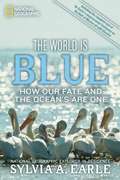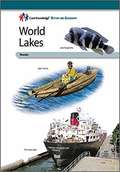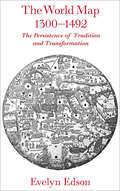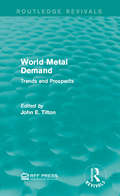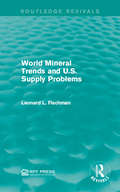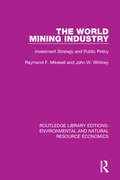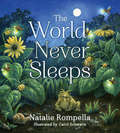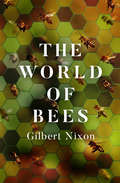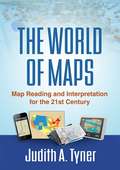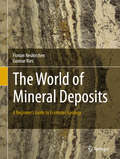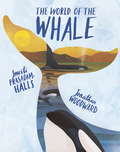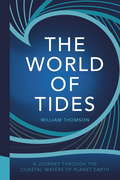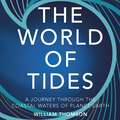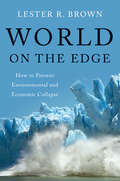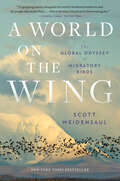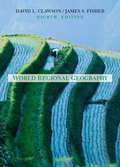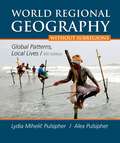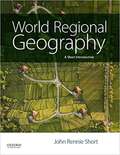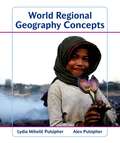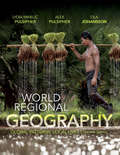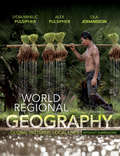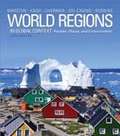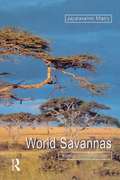- Table View
- List View
The World Is Blue: How Our Fate and the Ocean's Are One
by Sylvia A. EarleExplorer-in-residence at the National Geographic Society, oceanographer Earle adds blue to the green movement by explaining the importance of the earth's ocean to the health of its life. She begins by setting out the conventional vision of the ocean's limitless bounty for harvesting wildlife and infinite resiliency as the ultimate garbage disposal. Then she explains how the ocean is suffering from biodiversity loss, drilling, mining, shipping, spilling, and changing climate and chemistry. The final section surveys opportunities for reversing the tide by exploring and governing the ocean, smart aquaculture, and protective measures. Annotation c2009 Book News, Inc., Portland, OR (booknews.com)
The World Is Ours to Cherish: A Letter to a Child
by Mary Annaïse HeglarThis hopeful picture book--written in the style of a letter--gives kids an honest take on climate change and urges them to band together to help the planet.The world is a big, beautiful place full of natural wonders--everything from bees to rainfall can seem magical.The world is also changing. Climate change has already had a devastating effect on the planet.But it's not too late! If we work together and show a little more care, both for the environment and each other, we can keep this world beautiful.This moving debut from climate writer Mary Annaïse Heglar is perfect for budding environmentalists and anyone in need of a little hope for the future of our planet.
World Lakes (Core Knowledge History and Geography)
by Core Knowledge FoundationWORLD LAKES begins with a review of map skills and geographical terms. Students learn about the benefits and resources provided by lakes, including, in Asia, the Caspian and Aral Seas; in Africa, Lakes Victoria, Tanganyika, and Chad; in South America, Lakes Maracaibo and Titicaca; and, in North America, Lakes Superior, Huron, Michigan, Erie, and Ontario.
The World Map, 1300–1492: The Persistence of Tradition and Transformation
by Evelyn EdsonIn the two centuries before Columbus, mapmaking was transformed. The World Map, 1300–1492 investigates this important, transitional period of mapmaking. Beginning with a 1436 atlas of ten maps produced by Venetian Andrea Bianco, Evelyn Edson uses maps of the fourteenth and fifteenth centuries to examine how the discoveries of missionaries and merchants affected the content and configuration of world maps. She finds that both the makers and users of maps struggled with changes brought about by technological innovation—the compass, quadrant, and astrolabe—rediscovery of classical mapmaking approaches, and increased travel. To reconcile the tensions between the conservative and progressive worldviews, mapmakers used a careful blend of the old and the new to depict a world that was changing—and growing—before their eyes. This engaging and informative study reveals how the ingenuity, creativity, and adaptability of these craftsmen helped pave the way for an age of discovery.
The World Map, 1300–1492: The Persistence of Tradition and Transformation
by Evelyn EdsonA history of the development of world maps during the later medieval period in the centuries leading up to Columbus’s journey.In the two centuries before Columbus, mapmaking was transformed. The World Map, 1300–1492 investigates this important, transitional period of mapmaking. Beginning with a 1436 atlas of ten maps produced by Venetian Andrea Bianco, Evelyn Edson uses maps of the fourteenth and fifteenth centuries to examine how the discoveries of missionaries and merchants affected the content and configuration of world maps.She finds that both the makers and users of maps struggled with changes brought about by technological innovation?the compass, quadrant, and astrolabe?rediscovery of classical mapmaking approaches, and increased travel. To reconcile the tensions between the conservative and progressive worldviews, mapmakers used a careful blend of the old and the new to depict a world that was changing?and growing?before their eyes.This engaging and informative study reveals how the ingenuity, creativity, and adaptability of these craftsmen helped pave the way for an age of discovery.“A comprehensive and complex picture of the changing face of medieval geography. With the mastery of a formidable palette of historiographic knowledge and well-reasoned discussions of the sources, The World Map, 1300–1492 will certainly remain an important work to consult for both medieval and early modern scholars for many years to come.” —Ian J. Aebel, Terrae Incognitae
World Metal Demand: Trends and Prospects (Routledge Revivals)
by John E. TiltonIn the early 1970s, the post-World War II boom in world metal consumption came to a halt. As time passed, it became clear that what many first thought to be a cyclical downturn was instead a long-term, substantial decline in world metal demand. In this volume, first published in 1990, editor John E. Tilton and four fellow scholars of mineral economics analyse the causes and consequences of this decline and the prospects for future growth in world metal demand. This book will be of interest to students of business and environmental studies.
World Mineral Trends and U.S. Supply Problems (Routledge Revivals)
by Leonard L. FischmanEven though the United States relies heavily on imports for many non-fuel minerals, mineral supply has played only a small role in foreign policy since World War II. Originally published in 1980, this report investigates seven major non-fuel minerals in relation to long-term potential supply and price problems and any short-term issues that may arise to put concerns about supply in perspective for policy-makers. This title will be of interest to students of Environmental Studies and professionals.
The World Mining Industry: Investment Strategy and Public Policy (Routledge Library Editions: Environmental and Natural Resource Economics)
by Raymond F. Mikesell John W. WhitneyOriginally published in 1987. A powerful combination of the authors’ research and practical experience underpin this book’s treatment of management and financial strategy in the world mining industry. In contrast with highly theoretical economic treatises on the extractive industries, this account deals with the practical realities of the economic, technical and business structure of the industry, the managerial and investment strategies, and the principle public policy issues. This book will interest all students and researchers in resource economics and it will be useful to officials of mining companies, government agencies, and financing agencies. Economic geologists and environmentalists should also find it relevant to their interests.
The World Never Sleeps (Tilbury House Nature Book #0)
by Natalie Rompella Carol SchwartzMidnight. Stars speckle the darkness with bits of light. A cockroach skitters across the kitchen floor to snatch a forgotten breadcrumb. In the backyard, a spider weaves an intricate design on the fence. Winged insects dance and flicker in the porch light. Day and night, small creatures are busy working, eating, hunting, hiding. This nonfiction picture book reveals the hidden lives of insects and other small creatures from one midnight to the next. The world may appear to be sleeping in the dead of night, but it is not. As moonflowers open and stars shine, nature goes about her business. The world never sleeps. Natalie Rompella’s lyrical text is vividly complemented by Carol Schwartz’s watercolors. A cat roams through the illustrations—silent witness, in the house and in the yard, to the myriad lives of night and day. A sense of mystery pervades all—even the backmatter natural-history portraits of the animals met in the book. This nature book invites children into a parallel universe, one that teems with life while they sleep. Lexile Level 700; F&P Level O
The World of Bees
by Gilbert NixonAn entomologist presents a beautifully illustrated study of bees, from their behavior to social structures, colonies, and relationship to the environment. In this engaging and scholarly volume, entomologist Gilbert Nixon shares his lifelong fascination with bees. Nixon&’s childhood love of these curious insects led to decades of study as he learned to identify their distinctive markings and pursued the secrets of their mystifying behaviors.The World of Bees offers a comprehensive introduction to various species of bees, including honey bees, bumblebees, and leafcutter bees, as well as information on related insects such as botflies and wasps. With color illustrations by Arthur Smith, this expert volume covers all major topics in melittology, including mating habits, life cycles, pollination, bee dances, and more.
The World of Maps
by Judith A. TynerMaps have power--they can instruct, make life easier, mislead, or even lie. This engaging text provides the tools to read, analyze, and use any kind of map and assess its strengths and weaknesses. Requiring no advanced math skills, the book presents basic concepts of symbolization, scale, coordinate systems, and projections. It gives students a deeper understanding of the types of maps they encounter every day, from turn-by-turn driving directions to the TV weather report. Readers also learn how to use multiple maps and imagery to analyze an area or region. The book includes 168 figures, among them 22 color plates; most of the figures can be downloaded as PowerPoint slides from the companion website. Appendices contain a glossary, recommended resources, a table of commonly used projections, and more.
The World of Mineral Deposits: A Beginner's Guide to Economic Geology
by Florian Neukirchen Gunnar RiesThis vivid introduction to economic geology not only describes the most important deposit types, but also the processes involved in their formation. Magmatic, hydrothermal and sedimentary processes as well as weathering and alteration are explained in the framework of plate tectonics and the history of the Earth. The chapter about fossil fuels includes unconventional deposits and the much-debated fracking. Other topics covered are exploration, mining and economic aspects like commodity prices.
The World of the Whale
by Smriti Prasadam-HallsDive into the underwater world of whales and dolphins in this entrancing illustrated guide. Graceful and serene, intelligent and social, the whale is a wonder of the deep blue sea. And yet, whales rely on air to breathe - they are mammals, just like us.With breathtaking text, Smriti Prasadam-Halls explores the migrations, songs and family life of these mysterious creatures, and reveals the dangers they face from plastic, pollution and hunting. Wildlife illustrator Jonathan Woodward brings the marine world to life with stunning papercut collage artwork. An astonishing follow-up to the English 4-11 Award-winning book The Ways of the Wolf, which is also shortlisted for the SLA Award.'The expressive writing and the colourful, original artwork depict the lives of whales perfectly. Perceptively illustrating their strong social nature and intelligence, this beautiful book also explores the dangers faced by these incredible creatures and the need for us to work together to protect them.' - Whale & Dolphin Conservation
The World of Tides: A Journey Through the Coastal Waters of Planet Earth
by William ThomsonIn The Book of Tides, William Thomson took the reader on a mesmerising journey round the coast of Britain. Now, he sets out with his surfboard and tidal compass to encounter the waters of the world, charting his most extraordinary sights and experiences. These include the whirlpools of the Arctic circle, the world's biggest ever surfed wave off Portugal, the strongest whirlpool in Norway and, in Australia, the most dangerous rapids known to us.With the enticing combination of William's passionate text and collectable mapping illustrations, this is a book for anyone who feels the pull of the tides and call of the sea.FEATURING:New ZealandAustraliaPortugalFranceEnglandScotlandNorwayThe NetherlandsSpainIndonesiaChinaJapanUSACanadaBelize
The World of Tides: A Journey Through the Coastal Waters of Planet Earth
by William ThomsonIn The Book of Tides, William Thomson took the reader on a mesmerising journey round the coast of Britain. Now, he sets out with his surfboard and tidal compass to encounter the waters of the world, charting his most extraordinary sights and experiences. These include the whirlpools of the Arctic circle, the world's biggest ever surfed wave off Portugal, the strongest whirlpool in Norway and, in Australia, the most dangerous rapids known to us.With the enticing combination of William's passionate text and collectible mapping illustrations, this is a book for anyone who feels the pull of the tides and call of the sea.FEATURING:New ZealandAustraliaPortugalFranceEnglandScotlandNorwayThe NetherlandsSpainIndonesiaChinaJapanUSACanadaBelize(P)2017 Quercus Editions Limited
World on the Edge: How to Prevent Environmental and Economic Collapse
by Lester R. BrownIn this urgent time, World on the Edge calls out the pivotal environmental issues and how to solve them now. We are in a race between political and natural tipping points. Can we close coal-fired power plants fast enough to save the Greenland ice sheet and avoid catastrophic sea level rise? Can we raise water productivity fast enough to halt the depletion of aquifers and avoid water-driven food shortages? Can we cope with peak water and peak oil at the same time? These are some of the issues Lester R. Brown skillfully distills in World on the Edge. Bringing decades of research and analysis into play, he provides the responses needed to reclaim our future.
A World on the Wing: The Global Odyssey Of Migratory Birds
by Scott WeidensaulNew York Times Bestseller Finalist for the Los Angeles Times Book Prize A Library Journal Best Science and Technology Book of the Year An exhilarating exploration of the science and wonder of global bird migration. In the past two decades, our understanding of the navigational and physiological feats that enable birds to cross immense oceans, fly above the highest mountains, or remain in unbroken flight for months at a stretch has exploded. What we’ve learned of these key migrations—how billions of birds circumnavigate the globe, flying tens of thousands of miles between hemispheres on an annual basis—is nothing short of extraordinary. Bird migration entails almost unfathomable endurance, like a sparrow-sized sandpiper that will fly nonstop from Canada to Venezuela—the equivalent of running 126 consecutive marathons without food, water, or rest—avoiding dehydration by "drinking" moisture from its own muscles and organs, while orienting itself using the earth’s magnetic field through a form of quantum entanglement that made Einstein queasy. Crossing the Pacific Ocean in nine days of nonstop flight, as some birds do, leaves little time for sleep, but migrants can put half their brains to sleep for a few seconds at a time, alternating sides—and their reaction time actually improves. These and other revelations convey both the wonder of bird migration and its global sweep, from the mudflats of the Yellow Sea in China to the remote mountains of northeastern India to the dusty hills of southern Cyprus. This breathtaking work of nature writing from Pulitzer Prize finalist Scott Weidensaul also introduces readers to those scientists, researchers, and bird lovers trying to preserve global migratory patterns in the face of climate change and other environmental challenges. Drawing on his own extensive fieldwork, in A World on the Wing Weidensaul unveils with dazzling prose the miracle of nature taking place over our heads.
World Regional Geography: A Development Approach (8th edition)
by David L. Clawson Merrill L. JohnsonThis book is organized around the central theme of human development. Each author employs the human development theme to create a substantive volume on world regional geography that presents a vital, issues-oriented overview of the topic.
World Regional Geography: Global Patterns, Local Lives (Without Subregions) (Sixth Edition)
by Lydia Mihelic Pulsipher Alex A. Pulsipher Conrad Mac" GoodwinThe main goal of this book is to make global patterns of trade and consumption meaningful for students by showing how these patterns affect not only world regions but also ordinary people at the local level.
World Regional Geography: A Short Introduction
by John Rennie ShortWorld Regional Geography: A Short Introduction is a compact, focused, and affordable book that provides foundational materials with an emphasis on contemporary issues. The crisp text introduces students to the character of world regional geography--the distinctiveness of different parts of the world--but also the linkages and connections. Part One sets the scene: one introductory chapter discusses the opportunities and dangers in using maps, data, and different scales of analysis, while another surveys broad global trends. The second part of the book explores these trends in sharper focus in a concise geography of the major regions of the world: Central America and the Caribbean, South America, Europe, Russia and its neighbors, East Asia, South East Asia, South Asia, Middle East and North Africa, Sub-Saharan Africa, Australia and Oceania, and North America. Each chapter examines a region's environmental context, historical geography, economic transformation, urban and rural trends, social geography and geopolitics. Three features distinguish each regional chapter: · Focus spotlights a unique area within each region · Connections highlights a regional attribute that connects it to other regions · Subregions illustrates the diversity within each region This full-color text--featuring meticulously-crafted original maps--is ideal for instructors who prefer the versatility of a concise book with the advantage of a compelling text.
World Regional Geography Concepts
by Lydia Mihelic Pulsipher Alex A. PulsipherThe authors of World Regional Geography have answered the need for an exceptionally brief textbook for the evolving world regional course. In World Regional Geography Concepts, eight major thematic concepts frame the coverage and give students a way of approach the wealth of information in the text. Like the Pulsiphers' longer text, World Regional Geography Concepts emphasizes global trends and the interregional linkages that are changing lives throughout the world, humanizes geographical issues by representing the lives of women, men, and children in various regions of the globe.
World Regional Geography, Seventh Edition
by Lydia Mihelič Pulsipher Alex Pulsipher Ola JohanssonPulsipher's World Regional Geography, Seventh Edition, without Subregions shows the rich diversity of human life and demystifies global issues by representing the daily lives of men, women, and children in the various regions of our globe. The seventh edition uses a new thematic framework to organize information and help students think critically about the local and global impacts of environment; gender and population; urbanization; globalization and development; and power and politics. This edition is also available in a version that includes coverage of subregions (978-1-319-04804-4).
World Regional Geography (Without Subregions), Seventh Edition
by Lydia Mihelič Pulsipher Alex Pulsipher Ola JohanssonPulsipher's World Regional Geography, Seventh Edition, without Subregions shows the rich diversity of human life and demystifies global issues by representing the daily lives of men, women, and children in the various regions of our globe. The seventh edition uses a new thematic framework to organize information and help students think critically about the local and global impacts of environment; gender and population; urbanization; globalization and development; and power and politics. This edition is also available in a version that includes coverage of subregions (978-1-319-04804-4).
World Regions in Global Context: Peoples, Places, and Environments (5th Edition)
by Sallie A. Marston Paul L. Knox Diana M. Liverman Vincent J. Del Casino Paul F. RobbinsThe author provides a framework for understanding the global connections that affect the dynamic and complex relationships between people and the worlds they inhabit.
World Savannas: Ecology and Human Use
by Jayalaxshm Mistry Andrea BeradiAn interdisciplinary text on the world's savannas, covering the geography, ecology, economics and politics of savanna regions. Savannas are a distinct vegetation type, covering a third of the world's land surface area and supporting a fifth of the world's population. There has been a wide range of literature on the subject, but the majority of work has focused on the ecology or development of savanna areas, ignoring the wider interdisciplinary issues affecting contemporary savannas. World Savannas aims to buck this trend, providing students with an up-to-date and comprehensive introduction to the global importance of savannas.
